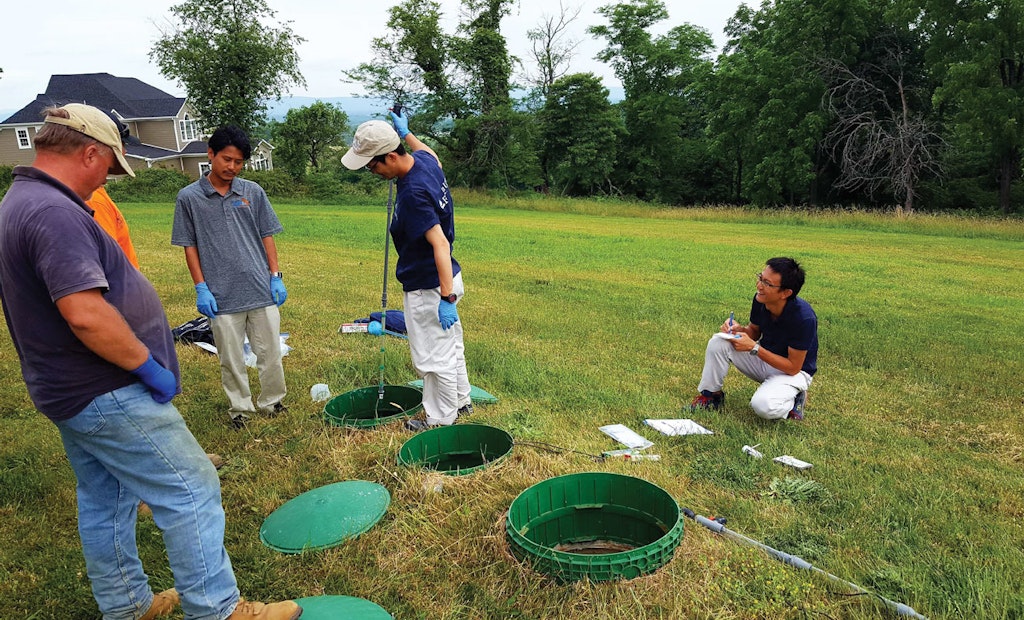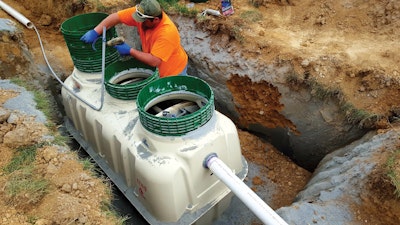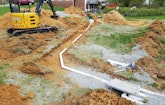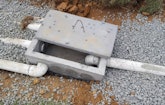
Dave Honeycutt (left), Joey Nagy (second from left in orange), from McKim Septic and three representatives of Fuji Clean USA take samples of the finished system in Loudoun County, Virginia. The pronounced slope of the property required installation of a French drain to divert surface water away from the new drainfield.
The old wastewater system at the house was failing. The system had a concrete tank and dated to about 1963. Loudoun County, Virginia, wouldn’t allow a new conventional system because there was no room for a new drainfield and no possibility for pretreatment. The old concrete tank and drainfield were abandoned.
The onsite designer selected a Fuji Clean USA system, and that led McKim Septic of Purcellville to install what may be the first Fuji Clean USA system in the county. Loudoun County is about 54 miles northwest of Washington, D.C.
Installation
Wastewater exits the home in a 4-inch PVC pipe that runs about 60 feet to the Fuji Clean USA tank. The system consists of only one fiberglass tank. The five-compartment Fuji Clean USA CEN5 fiber-reinforced plastic tank has a hydraulic load of 450 gpd and a total volume of 749 gallons divided into a sedimentation chamber (277 gallons), anaerobic chamber (278 gallons), aerobic contact filtration chamber (127 gallons), storage chamber (63 gallons), and disinfection chamber (4 gallons). Assuming an influent of typical household strength, the system effluent will have a BOD of 10 mg/L, TSS of 10 mg/L, and total nitrogen of 10 mg/L.
The system is driven by a FujiMac 80R11 that uses electromagnets, smaller diaphragms, and redesigned compression chambers that, Fuji Clean USA says, enable the pumps to run cooler, quieter, and with greater energy efficiency. A set of valves and an airlift pipe recirculates about 4-6 times daily flow to the head of the treatment chain.
Technicians set the blower next to the house and ran the air line beside the wastewater pipe. A Fuji Clean USA panel controls the system. There is an alarm to warn of air compressor failure, plus one float in the middle compartment to warn of high water.
From the Fuji Clean USA tank, water comes out in a 4-inch pipe and runs about 80 feet to a concrete distribution box from Winchester Building Supply in Winchester. Four 4-inch solid-wall PVC lines come out of the box and are connected to 80-foot-long laterals made with corrugated 4-inch perforated pipe.
The old drainfield was buried so deep that the new pipe could be laid almost on top of it. Laterals were laid in 3-foot-wide trenches between 12 and 14 inches deep. Pipes were bedded in native washed stone between 1/2 and 1 1/2 inches in diameter from Luck Stone. Geotextile fabric was laid on top, and that was covered with a foot of dirt.
Diverting water
The topography of the site also played a role. Water from properties across the street ran through the home’s yard. That had saturated the old drainfield and was the reason the county wanted pretreatment. McKim Septic technicians built a French drain to intercept water before it reaches the new drainfield.
To make the drain, technicians dug a trench about 1 foot deep and 100 feet long and laid 4-inch corrugated, perforated pipe. That was bedded in gravel. On one end, the pipe transitions to 4-inch solid-wall pipe that emerges onto the surface of the ground and discharges water into a nearby swale.
The company rented a John Deere 50G mini-excavator because the weight of the Fuji Clean USA tank was slightly more than what the company’s own Caterpillar mini-excavators can handle. A Takeuchi 130 skid-steer took care of the rest of the work.
Maintenance
Installation went smoothly, and using this system provided some definite advantages for the owner.
“It’s a whole lot smaller than other systems,” says Michelle McKim, whose parents own the company. The Fuji Clean USA system weighs maybe 500 or 600 pounds when it goes in the hole.
“Because of that, we didn’t have to bring in heavy equipment to handle the tank, and that kept the cost down for the owner and also held down the amount of disturbance to the property,” McKim says.
The Fuji Clean USA unit will be inspected twice a year. That means checking operations and also taking samples for a lab analysis to be filed with the state and county. Factory technicians worked with McKim Septic on the installation and also trained its workers in maintenance techniques.
“On top of the one we installed, we’re maintaining six others, and from what I’ve seen in visiting a few of the sites, the effluent quality in the tank is great,” says Austin Echols, technician.
Tracking performance
The state approved the use of the Fuji Clean system. County sanitarians are tracking the system’s performance to ensure it will work well under local conditions. County officials also visited the installation site to see the Fuji Clean USA and talk with company representatives, McKim says.
In Japan, the system works well, but there are differences in the behavior of Americans, McKim says. Americans use more water and garbage disposals, and they tend to put grease and other substances down their drains, she says.
The other benefit from this job was a couple of more jobs. Homeowners with their own wastewater system problems drove by, saw the work, saw the company logo on equipment, and hired McKim Septic to solve their problems.









